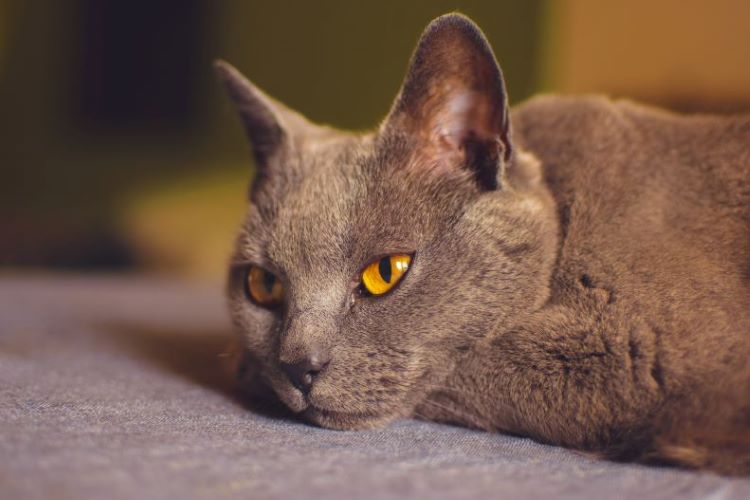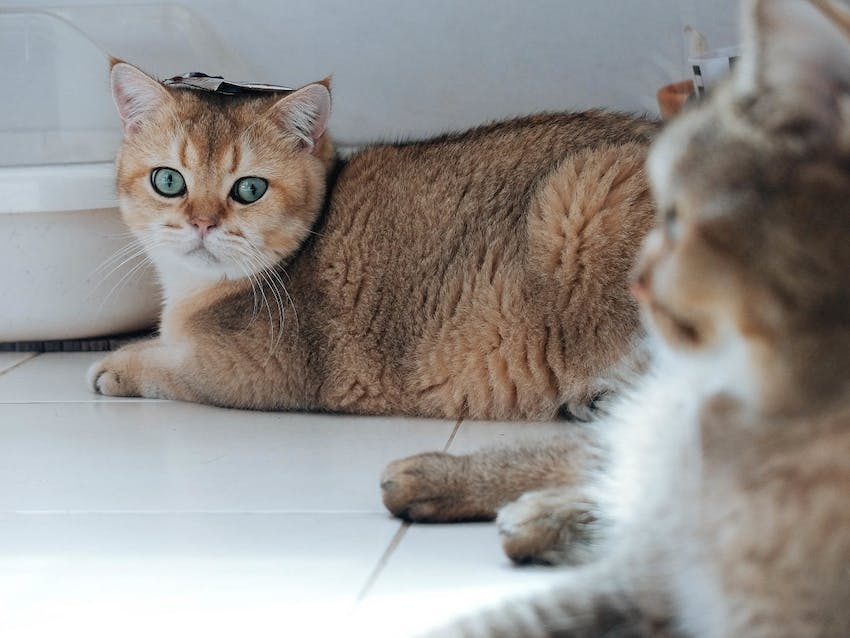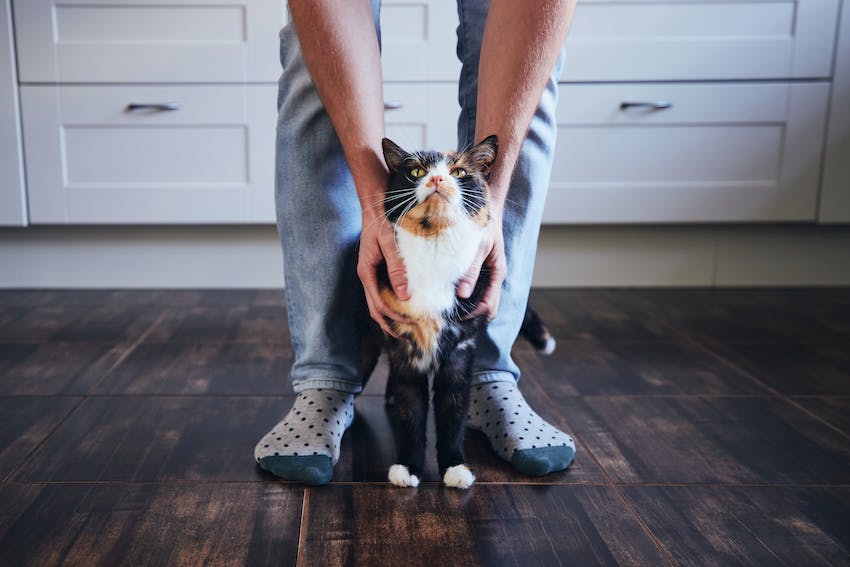Ready to help treat your pet to a healthy life?
Can Cats Get Dementia?
By : Dr. Katy Burr, DVM & Trupanion Staff | Updated Sep 14, 2023

Just like in humans, aging pets will undergo changes to their physical and mental health. Feline dementia may occur as a cat ages and is directly related to the aging of their brain. It is similar to dementia seen in humans, as it may influence a cat’s awareness, learning, memory, and responsiveness. It can also cause anxiety.
Whether you’re concerned that your pet may have feline dementia or you are dealing with a recent diagnosis, it’s a good idea to get as informed as possible. This starts with understanding what exactly dementia in cats is as well as what kind of treatment options may be available.
What is feline dementia?
Feline dementia, also known as Cognitive Dysfunction Syndrome (CDS) in cats, is a condition that affects older cats and is characterized by a decline in cognitive function similar to dementia in humans. This condition is relatively common in aging cats, and its symptoms can be distressing for both the cat and its owner.
CDS is characterized by behavioral changes. However, the behavioral changes associated with CDS can also result from other diseases, such as hyperthyroidism, chronic renal failure, diabetes mellitus, and more. Therefore, if you notice any changes in behavior in your senior or geriatric cat, it is very important to take it to the vet to get a proper diagnosis and rule out any of these other diseases. CDS can only be diagnosed once all other illnesses have been ruled out and you can utilize your cat insurance to help cover the costs associated with feline dementia.
Signs of feline dementia or ‘CDS’
- Disorientation: Affected cats may become disoriented or confused, often getting lost in familiar surroundings or failing to recognize their owners.
- Changes in sleep patterns: Cats with CDS may exhibit changes in their sleep-wake cycle, such as increased nighttime activity and restlessness, or excessive daytime sleepiness.
- Altered behavior: Cats may display changes in behavior, including increased irritability, anxiety, or aggression. They may also lose interest in grooming themselves.
- Inappropriate elimination: Some cats with CDS may forget their litter box training and start urinating or defecating in inappropriate places.
- Reduced appetite: A decrease in appetite or interest in food is common in cats with CDS, leading to weight loss.
- Vocalization: Some cats may become more vocal or meow excessively, often without an apparent reason.
- Reduced social interaction: Cats may withdraw from social interactions with humans or other pets.
- Repetitive behaviors: Cats with CDS may engage in repetitive activities, such as pacing or circling.
Causes
The exact cause of feline dementia and its variants is not fully understood. However, the condition is believed to be related to brain changes associated with aging. Factors such as genetics, diet, and environmental factors may also contribute to the development and progression of CDS.
Feline senile dementia vs dementia
Dementia is often incorrectly referred to as "senility" or "senile dementia," which reflects the formerly widespread but incorrect belief that serious mental decline is a normal part of aging in cats. While senility is loosely used to describe cognitive loss, dementia is the current accepted medical term.

Feline dementia treatment
Although sadly CDS cannot be cured, the signs of it can be reduced with suitable management. This includes making changes to the cat’s environment, adjusting or supplementing their diet, and drug therapy.
It’s important to talk with your pet’s veterinarian about symptom management and maintaining quality of life for your cat. Your veterinarian may suggest a variety of treatment options for those suffering from feline senile dementia. While there is no cure for cognitive decline, there are multiple things you can do to support your cat and maintain their wellbeing.
Environmental management
Changing environmental factors can help a cat with CDS such as enhancing the cat’s environment with extra toys, increasing the amount of time you spend with the cat, increasing your interaction through play, providing hiding places, elevated sites, and providing puzzle feeders. These are all known as environmental enrichment, which can lead to increased mental stimulation, an increase in the growth and survival of nerve cells in the brain, and an increase in cognitive function. Just be sure to introduce changes to your cat’s environment gradually, so as not to confuse them.
Other adjustments to the environment can be made to make life easier for the elderly cat and reduce potential frustration and stress. These include:
- Avoid placing food and water on high surfaces that elderly cats might find difficult to access or provide a ramp up to the surface if you do.
- Raise food and water bowls up slightly from the floor, to make it easier for the cat to reach them, especially arthritic cats. Ensure that food and water bowls are separated.
- Provide several comfortable beds in easily accessible areas; consider providing heated beds for added comfort.
- Provide large, low-sided litter trays for easy access and place them in easily accessible locations.
- Provide soft litter which are softer on the paws.
- Consider letting them in and out via a door as elderly cats may find it more difficult to use cat flaps.
- Allow elderly cats to have peace and quiet, away from other pets and members of the household, when they want it.
- Avoid introducing a new cat or dog — this can be very stressful for elderly cats.
A final environmental factor that could be introduced to help a cat with CDS is a synthetic version of a feline facial pheromone, known as Feliway Classic, as this can help to reduce anxiety.
Addressing severe cognitive dysfunction in cats
Unfortunately, when cats develop many signs of CDS, indicating that their cognitive abilities have declined severely, changes to their environment can actually make things worse. Cats with severe CDS are easily stressed, which could exacerbate the effects of CDS, therefore, any changes should be kept to a minimum or avoided altogether. Some cats may even benefit from having their area of access reduced, providing them with a single room with all their key resources where they can feel safe and secure.
Dietary management and drug therapy
Drug therapy for feline dementia can be a component of a comprehensive treatment plan to manage the condition. While there is no cure for CDS, certain medications may help alleviate some of the cognitive and behavioral symptoms. It's essential to work closely with your veterinarian to determine the most appropriate treatment options for your cat, as individual responses to these drugs can vary.
Here are some commonly used treatments to manage feline dementia:
- Selegiline (Anipryl): Selegiline is a medication that has been used to treat CDS in cats. It works by increasing the levels of certain neurotransmitters in the brain, potentially improving cognitive function and reducing behavioral symptoms. Your veterinarian will determine the appropriate dosage and monitor your cat's response to this medication.
- Antioxidants: Antioxidants like Vitamin E and Vitamin C may help reduce oxidative stress in the brain, which is believed to contribute to cognitive decline. These supplements can be administered under the guidance of a veterinarian.
- Omega-3 Fatty Acids: Omega-3 fatty acids, found in fish oil supplements, have anti-inflammatory properties and may support brain health. They are often included as part of a comprehensive treatment plan for CDS.
- Prescription Diets: Some commercial cat foods are specially formulated to support brain health in senior cats. These diets typically contain antioxidants and other nutrients believed to be beneficial for cognitive function.
It's crucial to note that drug therapy alone may not be sufficient to manage feline dementia. A holistic approach that includes environmental enrichment, a consistent routine, and regular veterinary check-ups is essential. Additionally, the response to medication can vary among individual cats, and not all cats will benefit from drug therapy.

How long can a cat live with dementia?
The lifespan of a cat with dementia, or cognitive dysfunction syndrome (CDS), can vary depending on several factors, including the cat's overall health, the severity of the cognitive dysfunction, and the effectiveness of management strategies and treatments. Cats with CDS can live for several years after the onset of symptoms, but it's essential to consider their quality of life.
There are several factors to consider when assessing the need for euthanasia in a cat with dementia.
Quality of life
The primary consideration should be your cat's quality of life. Monitor their behavior, comfort, and overall well-being. Cats with severe CDS may experience confusion, anxiety, disorientation, and changes in behavior that impact their quality of life.
Pain and suffering
Evaluate whether your cat is in pain or suffering due to their cognitive dysfunction. If they are experiencing distress that cannot be alleviated through management and treatment, it may be a sign that their quality of life is compromised.
Basic needs
Ensure that your cat can still meet their basic needs, such as eating, drinking, grooming, and using the litter box. Cognitive dysfunction can sometimes lead to difficulties in performing these essential functions.
Response to treatment
Consider the response to any treatment, including medication and environmental enrichment. If the treatments are not providing significant relief or if the cat's condition continues to deteriorate despite efforts, it may be time to discuss euthanasia.
Comfort and stress
Cats with advanced CDS may become more stressed or agitated, which can negatively affect their well-being. Ensure that they have a comfortable and stress-free environment.
End of life care options
Meet with your veterinarian regularly to assess your cat's condition and discuss their prognosis, as this can help you make informed decisions about your cat's care. If euthanasia becomes a consideration, your vet can guide you on when it may be appropriate and ensure that it is done in a humane and compassionate manner.
Euthanasia is a difficult decision, but it can be a compassionate choice to prevent unnecessary suffering when a cat's quality of life is significantly compromised due to cognitive dysfunction or other serious health issues. Your veterinarian can offer guidance and support during this challenging time and help you determine when it may be the most humane option for your beloved feline companion.
Getting the best treatment for your pet
Finding out your cat is suffering from dementia or any other degenerative cognitive condition is scary. However, it is important to know that many cats who are diagnosed have a lot of quality time left with their humans providing proper treatment is administered. Having an honest and open discussion with your veterinarian about your pet’s prognosis and symptoms is the first step. At the end of the day, your pet’s comfort and wellbeing will be the most important factors.
You can also exercise your cat health insurance and ask about specific diets for brain illnesses. Diets supplemented with antioxidants, vitamin E and C, selenium, flavonoids, beta carotene, carotenoids, Omega-3, and carnitine can all help improve cognitive functions. Your vet may also recommend medication to treat your cat’s anxiety if it is particularly severe.
If you have any further questions about feline senile dementia, consult your veterinarian who can provide tailored, expert advice.
